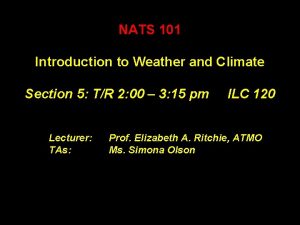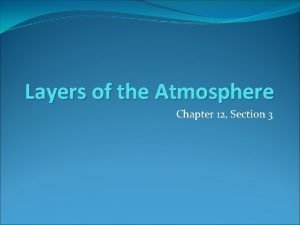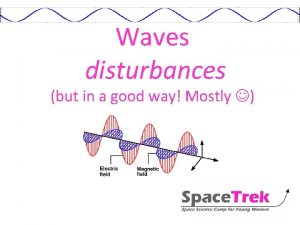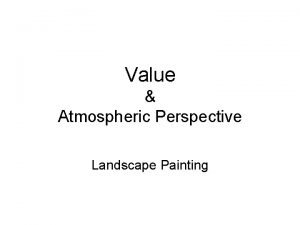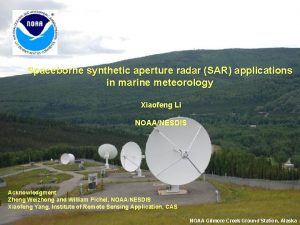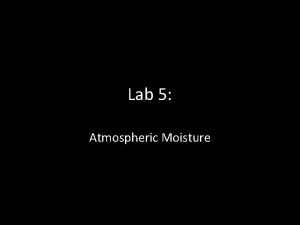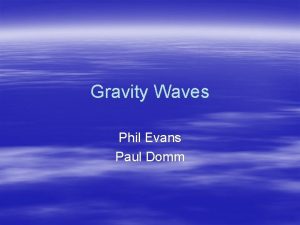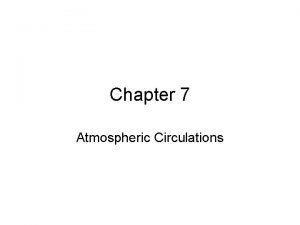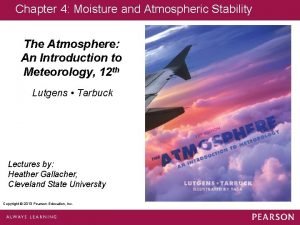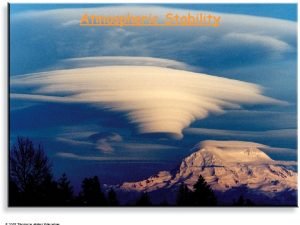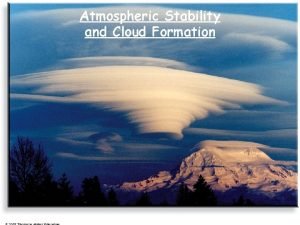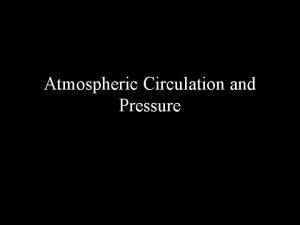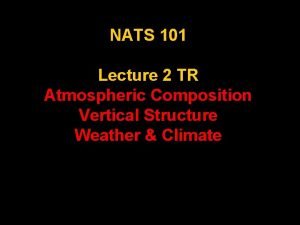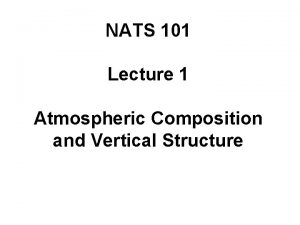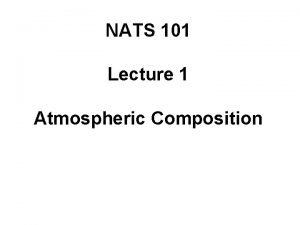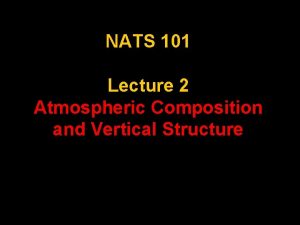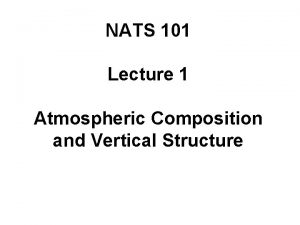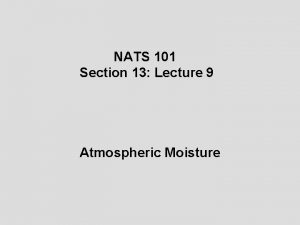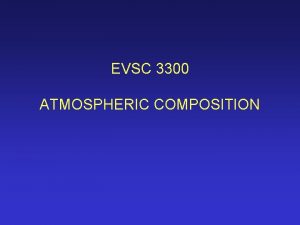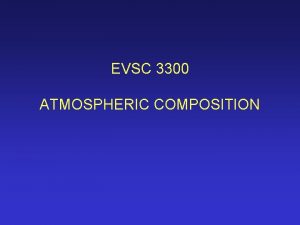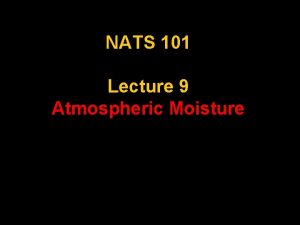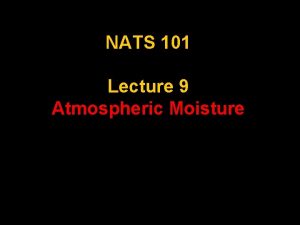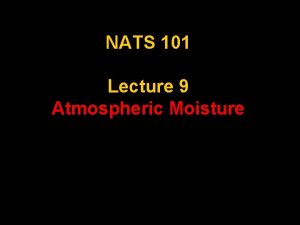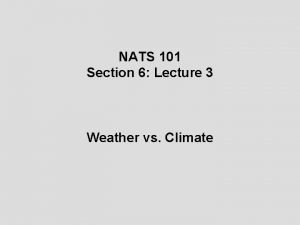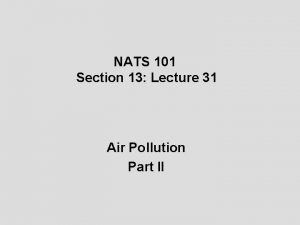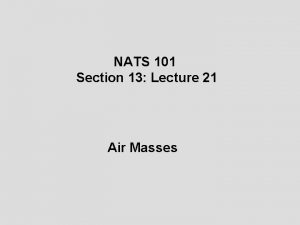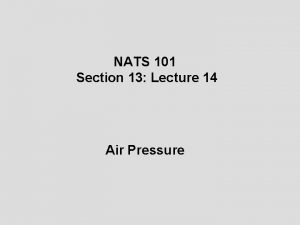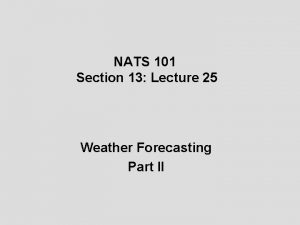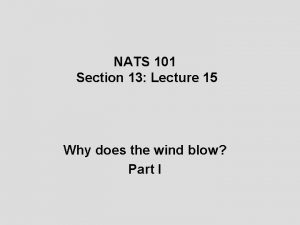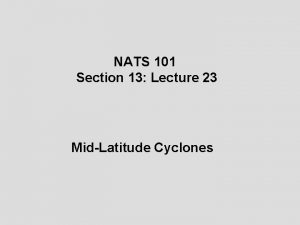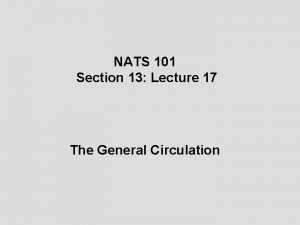NATS 101 Section 4 Lecture 2 Atmospheric Composition























- Slides: 23

NATS 101 Section 4: Lecture 2 Atmospheric Composition and Structure

Composition of the Dry Atmosphere Gas Chemical symbol % of Atmosphere Nitrogen N 2 78. 08 Oxygen O 2 20. 95 Argon Ar 0. 93 Neon Ne 0. 0018 Helium He 0. 0005 Hydrogen H 2 0. 00006 Xenon Xe 0. 000009 Chemically active Inert gases (not reactive)

Important Trace Gases Gas Chemical symbol Concentration (ppm) Carbon dioxide CO 2 380 (at present) Methane CH 4 1. 7 Nitrous Oxide N 2 O 0. 3 Ozone O 3 0. 04 Particulates Chloroflourocarbons ppm = parts per million 0. 01 -0. 15 CFCs 0. 0002

Carbon Dioxide (CO 2) The “Keeling curve” shows increase in atmospheric carbon dioxide at Mauna Loa since 1950 s

Stratospheric Ozone and CFCs Stratospheric ozone protects from Sun’s UV rays. An ozone hole occurs over the polar regions because of: 1. 2. 3. (NASA imagery)

Water Vapor Water vapor is highly dependent on the given weather conditions and local climate. It also plays a big role in the Earth’s energy budget, as we’ll see later… What is measure which is typically used in the weather report? ? Model forecast output (from NCAR).

Mass, Force, Weight, Density, and Pressure

What is mass? Mass is an intrinsic property based on the molecular composition of matter. As long as the amount of matter does not change, it’s mass remains constant—regardless of location. SI units of mass: grams (g) or kilograms (kg) SI Units = Système Internationale Units

Some SI Units we’ll use in next few lectures Quantity Name (Symbol) SI Units Length meter m Time second s Mass grams or kilograms g or kg Area Volume ALL quantities are derived from: LENGTH TIME MASS Density Frequency Velocity or speed Acceleration Force Pressure Energy Fill in the blanks on the unit measures, with appropriate notation, on your own as an exercise.

FORCE = Or, as an equation… F= SI Units: kg m s-2 or (named after which famous physicist? )

What is weight? NOT the same as mass! The concept of weight is a specific application of the concept of force: Weight (W) is the force on an object to the gravitational acceleration (g): W= Weight = Try to verify the correct SI units in the calculation…

Weight is dependent on the size of the attracting body… Newton’s law of gravitation indicates that the gravitation acceleration is dependent on the size of the body. The more massive, the bigger g. g of Moon = 1. 6 m s-2 (About 1/6 of Earth) g of Earth = 9. 8 m s-2

What is density? Density (ρ) is the mass (m) per unit volume (V): SI Units:

Changes in density DECREASES when: Density INCREASES when: Mass decreases or volume increases Mass increases or volume decreases a b Original box Add more mass Decrease volume

What is pressure? Pressure (P) is the force per unit area (A) Blaise Pascal SI Units: The typical unit of atmospheric pressure is millibars 1 mb = (SI unit of pressure from above) The air pressure at the surface of the Earth at sea level is defined as 1 Atmosphere (Atm): “Atmosphere” 1 Atm =

Air pressure Top Higher elevation Less air above Lower pressure Bottom Lower elevation More air above Higher pressure Increasing pressure Given the mathematical definitions we’ve already discussed, air pressure can be thought of as the weight of a column of air above you.

Change in density and pressure with height Density and pressure decrease exponentially with height. For each 16 km in altitude, the pressure decreases by a factor of 10. .

Equation for pressure variation Given that we know atmospheric pressure changes exponentially with height, we can apply this relationship to derive the air pressure at various altitudes above sea level: OR e = exponential function = 2. 71828…. Z= Elevation in kilometers P = pressure in mb at location PMSL = mean sea level pressure in mb =

Surface pressure Tucson vs. Humphrey’s Peak: Elevation 3850 m Highest Point in AZ Tucson: Elevation 728 m

Using equation for pressure variation TUCSON P = 912 mb HUMPHREY’S PEAK

Change in Temperature with Height Changes in temperature are more complicated and have to do with the radiative processes in different parts of the atmosphere (more on that later…) inversion isothermal 6. 5 o. C/km The rate of change of temperature with height is called the lapse rate. Positive lapse rate mean temperature decrease with height. The places where the sign of the lapse rate changes defines the different levels of the atmosphere.

Atmospheric Layers • Troposphere (surface – 11 km): Nearly all of what we think of as “weather” happens here. Lapse rate of 6. 5 °C per km. “Tropo” = Greek for • Stratosphere (11 km – 50 km): Where the ozone layer is located and Sun’s UV rays are absorbed by photodissociation. “Strato” = Greek for • Mesosphere (50 km – 90 km) • Thermosphere: (90 km – 500 km): Ionization of atmospheric gases • Exosphere (500 km): Basically outer space…

Summary of Lecture 2 The atmosphere is composed of chemically active and inert gases. The “important” gases affect the Earth’s energy budget and/or atmospheric chemistry. Carbon dioxide, water vapor, and ozone are good examples. We defined mass, force, weight, density, and pressure. Know how each of these are derived, what they physically mean, and their SI units of measurement. Pressure can be thought of as the weight of a column of air above you, and it decreases exponentially with height. A simple equation was presented with relates the variation in pressure with height. Temperature changes with height are more complicated and have to do with radiative processes in different parts of the atmosphere. Places where the lapse rate changes define the various atmospheric layers.
 Mats apprentice
Mats apprentice Nats weather
Nats weather Atmospheric physics lecture notes
Atmospheric physics lecture notes Atmospheric chemistry lecture notes
Atmospheric chemistry lecture notes The four main layers of the atmosphere
The four main layers of the atmosphere 01:640:244 lecture notes - lecture 15: plat, idah, farad
01:640:244 lecture notes - lecture 15: plat, idah, farad What is a harmonic wave in physics
What is a harmonic wave in physics Lecture 101
Lecture 101 Physics 101 lecture 1
Physics 101 lecture 1 Physics 101 lecture notes pdf
Physics 101 lecture notes pdf What is wave motion
What is wave motion Atmospheric opacity
Atmospheric opacity Landscape atmospheric perspective
Landscape atmospheric perspective Atmospheric diving system
Atmospheric diving system Atmospheric gravity waves
Atmospheric gravity waves Penn state department of meteorology
Penn state department of meteorology Lab 5 atmospheric moisture
Lab 5 atmospheric moisture Air pressure at different altitudes
Air pressure at different altitudes Atmospheric gravity waves
Atmospheric gravity waves Single cell model of atmospheric circulation
Single cell model of atmospheric circulation Atmospheric stability
Atmospheric stability Define unstable equilibrium
Define unstable equilibrium Atmospheric stability
Atmospheric stability Circulates air between 60-90 latitudes
Circulates air between 60-90 latitudes

